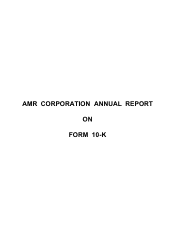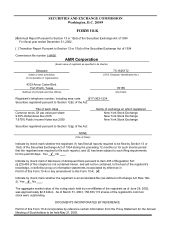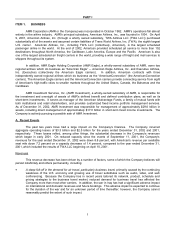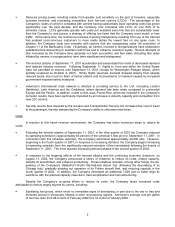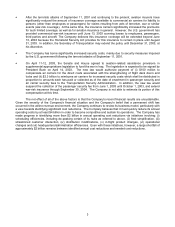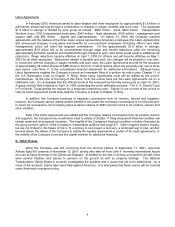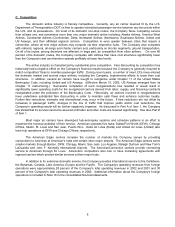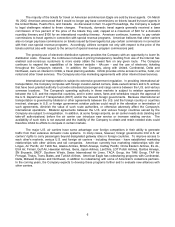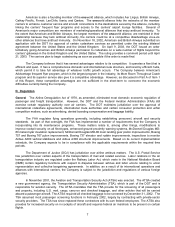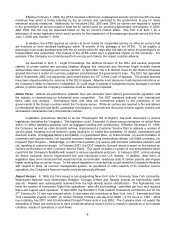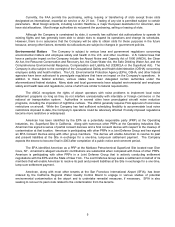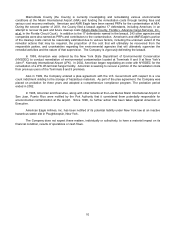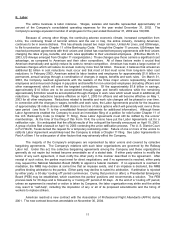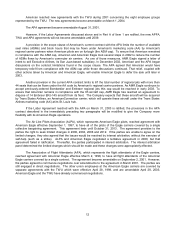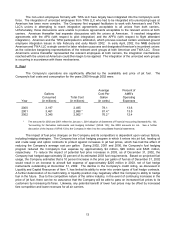American Airlines 2002 Annual Report Download - page 5
Download and view the complete annual report
Please find page 5 of the 2002 American Airlines annual report below. You can navigate through the pages in the report by either clicking on the pages listed below, or by using the keyword search tool below to find specific information within the annual report.3
• After the terrorists attacks of September 11, 2001 and continuing to the present, aviation insurers have
significantly reduced the amount of insurance coverage available to commercial air carriers for liability to
persons (other than employees or passengers) for claims resulting from acts of terrorism, war or similar
events (war-risk coverage). At the same time, the insurance carriers significantly increased the premiums
for such limited coverage, as well as for aviation insurance in general. However, the U.S. government has
provided commercial war-risk insurance until June 13, 2003 covering losses to employees, passengers,
third parties and aircraft. The Company believes this insurance coverage will be extended beyond June
13, 2003 because the Homeland Security Act provides for this insurance to remain in place until August
31, 2003. In addition, the Secretary of Transportation may extend the policy until December 31, 2003, at
his discretion.
• The Company has borne significantly increased security costs, mainly due to security measures imposed
by the U.S. government following the terrorist attacks of September 11, 2001.
• On April 11-12, 2003, the Senate and House agreed to aviation-related assistance provisions in
supplemental appropriations legislation to fund the war in Iraq. The legislation is expected to be signed by
President Bush on April 14, 2003. The new law would authorize payment of (i) $100 million to
compensate air carriers for the direct costs associated with the strengthening of flight deck doors and
locks and (ii) $2.3 billion to reimburse air carriers for increased security costs which shall be distributed in
proportion to amounts each has paid or collected as of the date of enactment in passenger security and
air carrier security fees to the Transportation Security Administration. In addition, the new law would
suspend the collection of the passenger security fee from June 1, 2003 until October 1, 2003, and extend
war-risk insurance through September 30, 2004. The Company is not able to estimate its portion of this
compensation at this time.
The net effect of all of the above factors is that the Company’s recent financial results are unsustainable.
Given the severity of the Company's financial situation and the Company’s belief that a permanent shift has
occurred in the airline revenue environment, the Company continues to review its business model, particularly with
a view towards identifying significant cost reductions. The Company believes that it must quickly reduce its annual
operating costs by at least $4 billion in order to become competitive and sustain its operations. The Company has
made progress in identifying more than $2 billion in annual operating cost reductions via initiatives involving: (i)
scheduling efficiencies, including de-peaking certain of its hubs as referred to above, (ii) fleet simplification, (iii)
streamlined customer interaction, (iv) distribution modifications, (v) in-flight product changes, (vi) operational
changes and (vii) headquarters/administration efficiencies. Even with these initiatives, however, a large shortfall of
approximately $2 billion remains between identified annual cost reductions and needed cost reductions.

